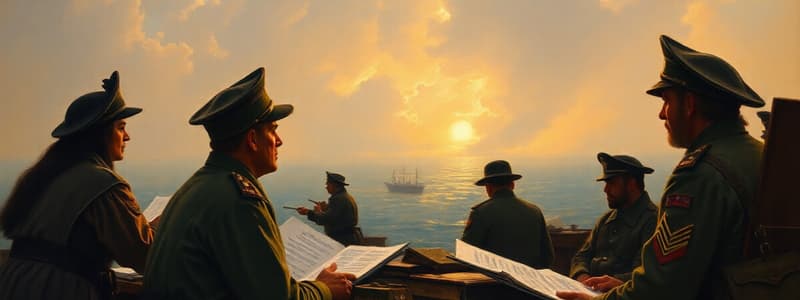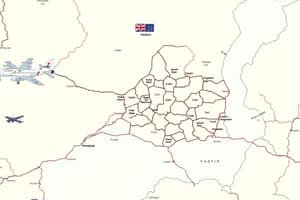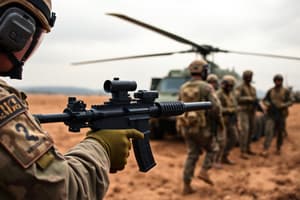Podcast
Questions and Answers
What is the primary purpose of the information collection plan in military operations?
What is the primary purpose of the information collection plan in military operations?
To task, direct, and manage collection assets to gather intelligence against specified requirements.
How does the operations officer contribute to information collection activities?
How does the operations officer contribute to information collection activities?
The operations officer tasks and directs information collection activities to fulfill the commander's requirements.
What does annex L in an operation order address?
What does annex L in an operation order address?
Annex L addresses the information collection tasks assigned to various assets for the collection effort.
Why is it important to evaluate assigned and attached assets before tasking them for information collection?
Why is it important to evaluate assigned and attached assets before tasking them for information collection?
What should be done if a collection task exceeds the capabilities of assigned and attached assets?
What should be done if a collection task exceeds the capabilities of assigned and attached assets?
What role does tasking and directing play in the information collection process?
What role does tasking and directing play in the information collection process?
What are some types of orders used to accomplish tasking in information collection?
What are some types of orders used to accomplish tasking in information collection?
Identify the four primary considerations outlined in the information collection plan.
Identify the four primary considerations outlined in the information collection plan.
How does the staff ensure the information collection plan remains effective during execution?
How does the staff ensure the information collection plan remains effective during execution?
What is the significance of redundancy, mix, and cue in information collection tasking?
What is the significance of redundancy, mix, and cue in information collection tasking?
What are named areas of interest (NAIs) and target areas of interest (TAIs) used for?
What are named areas of interest (NAIs) and target areas of interest (TAIs) used for?
What is meant by the term critical information requirements (CCIRs) in the context of information collection?
What is meant by the term critical information requirements (CCIRs) in the context of information collection?
Describe the process of retasking in information collection.
Describe the process of retasking in information collection.
What are essential elements of information in intelligence?
What are essential elements of information in intelligence?
How does threat activity influence the course of action in intelligence?
How does threat activity influence the course of action in intelligence?
What is the role of a priority within the context of intelligence?
What is the role of a priority within the context of intelligence?
Define the term 'course of action' as it relates to intelligence.
Define the term 'course of action' as it relates to intelligence.
What characteristics can the essential elements of information possess?
What characteristics can the essential elements of information possess?
Why is it important to identify subsets of information in intelligence operations?
Why is it important to identify subsets of information in intelligence operations?
In what ways can elements of intelligence influence decision-making?
In what ways can elements of intelligence influence decision-making?
How can positive or negative indicators impact intelligence analysis?
How can positive or negative indicators impact intelligence analysis?
What is the primary purpose of an information collection plan in a military context?
What is the primary purpose of an information collection plan in a military context?
In what scenarios might an information collection plan be issued earlier than usual?
In what scenarios might an information collection plan be issued earlier than usual?
What are fragmentary orders used for in the context of information collection?
What are fragmentary orders used for in the context of information collection?
What factors do staffs monitor to adapt their reporting times during an operation?
What factors do staffs monitor to adapt their reporting times during an operation?
What items are typically depicted on an information collection overlay?
What items are typically depicted on an information collection overlay?
How do incorrect assumptions about enemy courses of action affect operational timelines?
How do incorrect assumptions about enemy courses of action affect operational timelines?
What does the information collection scheme of support entail?
What does the information collection scheme of support entail?
What is the purpose of correlating information reporting to original requirements?
What is the purpose of correlating information reporting to original requirements?
How do limits of reconnaissance affect reconnaissance units?
How do limits of reconnaissance affect reconnaissance units?
What are the roles of counterreconnaissance areas in an information collection plan?
What are the roles of counterreconnaissance areas in an information collection plan?
What challenges might the intelligence analysis section face when handling large volumes of information?
What challenges might the intelligence analysis section face when handling large volumes of information?
Why is it important for staff to assess whether a collection task has been satisfied when screening reports?
Why is it important for staff to assess whether a collection task has been satisfied when screening reports?
List two types of logistical support included in the information collection scheme of support.
List two types of logistical support included in the information collection scheme of support.
How do staff members link production tasks to requirements effectively?
How do staff members link production tasks to requirements effectively?
What are some consequences of reports that partially satisfy collection tasks?
What are some consequences of reports that partially satisfy collection tasks?
What might be seen as unnecessary during the intelligence reporting process?
What might be seen as unnecessary during the intelligence reporting process?
What is the role of the intelligence staff in updating the information collection plan?
What is the role of the intelligence staff in updating the information collection plan?
How do the intelligence and operations staffs ensure minimal casualties during collection?
How do the intelligence and operations staffs ensure minimal casualties during collection?
What action is taken by the staff when requirements are satisfied or become irrelevant?
What action is taken by the staff when requirements are satisfied or become irrelevant?
What steps does the intelligence staff take when new requirements are developed?
What steps does the intelligence staff take when new requirements are developed?
What conditions may lead to the retasking of assets?
What conditions may lead to the retasking of assets?
What is the significance of eliminating satisfied requirements in the context of military operations?
What is the significance of eliminating satisfied requirements in the context of military operations?
How does coordinating with other staff sections benefit the information collection process?
How does coordinating with other staff sections benefit the information collection process?
Why might the intelligence staff have to adjust the LTIOV?
Why might the intelligence staff have to adjust the LTIOV?
Flashcards
Information Collection Plan
Information Collection Plan
A document that outlines how information will be collected, who will collect it, and the specific requirements for the information.
Annex L
Annex L
A section of an operation order that details the information collection tasks and assets.
Information Collection Warning Order
Information Collection Warning Order
A formal directive issued to subordinate units outlining planned information collection efforts.
Requirement Planning Tools
Requirement Planning Tools
Signup and view all the flashcards
Information Collection Matrix
Information Collection Matrix
Signup and view all the flashcards
Essential Information
Essential Information
Signup and view all the flashcards
Evidence of Threat Activity
Evidence of Threat Activity
Signup and view all the flashcards
Factors Influencing Decision
Factors Influencing Decision
Signup and view all the flashcards
Positive Evidence
Positive Evidence
Signup and view all the flashcards
Negative Evidence
Negative Evidence
Signup and view all the flashcards
Related Information
Related Information
Signup and view all the flashcards
Requirements for Assessment
Requirements for Assessment
Signup and view all the flashcards
A Subset of Information
A Subset of Information
Signup and view all the flashcards
Information Collection Tasking
Information Collection Tasking
Signup and view all the flashcards
Information Collection Overlay
Information Collection Overlay
Signup and view all the flashcards
Information Collection Scheme of Support
Information Collection Scheme of Support
Signup and view all the flashcards
Planning Information Collection Activities
Planning Information Collection Activities
Signup and view all the flashcards
Tasking and Directing Information Collection
Tasking and Directing Information Collection
Signup and view all the flashcards
Retasking Information Collection
Retasking Information Collection
Signup and view all the flashcards
Information Collection Plan as an Execution Order
Information Collection Plan as an Execution Order
Signup and view all the flashcards
What is an information collection plan?
What is an information collection plan?
Signup and view all the flashcards
When is an information collection plan issued?
When is an information collection plan issued?
Signup and view all the flashcards
What is an information collection overlay?
What is an information collection overlay?
Signup and view all the flashcards
What does an information collection overlay typically include?
What does an information collection overlay typically include?
Signup and view all the flashcards
What is the information collection scheme of support?
What is the information collection scheme of support?
Signup and view all the flashcards
What aspects of support are included in the information collection scheme of support?
What aspects of support are included in the information collection scheme of support?
Signup and view all the flashcards
What is the main function of an information collection plan?
What is the main function of an information collection plan?
Signup and view all the flashcards
What is the importance of the information collection plan in military operations?
What is the importance of the information collection plan in military operations?
Signup and view all the flashcards
Requirements Management
Requirements Management
Signup and view all the flashcards
Correlating Reports to Requirements
Correlating Reports to Requirements
Signup and view all the flashcards
Tracking Collection Task Completion
Tracking Collection Task Completion
Signup and view all the flashcards
Screening Information Reports
Screening Information Reports
Signup and view all the flashcards
Adjusting Reporting Times
Adjusting Reporting Times
Signup and view all the flashcards
Adapting Plans to New Intelligence
Adapting Plans to New Intelligence
Signup and view all the flashcards
Abbreviated IPB
Abbreviated IPB
Signup and view all the flashcards
Managing Information Overload
Managing Information Overload
Signup and view all the flashcards
Refining the Information Collection Plan
Refining the Information Collection Plan
Signup and view all the flashcards
Retasking Assets
Retasking Assets
Signup and view all the flashcards
Eliminating Satisfied Requirements
Eliminating Satisfied Requirements
Signup and view all the flashcards
Developing New Requirements
Developing New Requirements
Signup and view all the flashcards
Cueing and Teaming Assets
Cueing and Teaming Assets
Signup and view all the flashcards
Prioritizing New Requirements
Prioritizing New Requirements
Signup and view all the flashcards
Supporting Branches
Supporting Branches
Signup and view all the flashcards
Adjusting the Information Collection Plan
Adjusting the Information Collection Plan
Signup and view all the flashcards
Study Notes
Information Collection Tasking and Directing
- The chapter details the importance of tasking and directing information collection, outlining how staff finalize plans and develop overlays.
- Operations staff integrates collection assets across all warfighting functions, utilizing redundancy, mix, and cueing as needed.
- Information collection activities begin once requirements are established, validated, and prioritized.
- Staffs use warning orders, fragmentary orders, and operation orders for tasking and continuously monitor operations for directing information collection assets.
Importance of Tasking and Directing
- Information collection tasking is crucial for controlling limited collection assets, and involves recommendations for redundancy, mix, and cueing.
- Planning information collection starts after requirements are established, prioritized, and validated.
Final Information Collection Plan
- A fully synchronized, efficient, and effective information collection plan requires several activities and reviews.
- Updating information collection during operations is crucial for adjustments.
- The plan is implemented through asset tasking, providing selected assets with prioritized information requirements.
- Requirements include what to collect (information requirements, NAIs/TAIs, and when/how long), and why (commander's critical info requirements).
- The plan is a warning order, operation order, or fragmentary order, and the operations officer tasks and directs. Intelligence staff assists with planning.
Information Collection Overlay
- A graphic representation of the information collection plan is presented in an appendix to the operation order.
- Elements include reconnaissance handover lines, friendly boundaries/phase lines, NAIs/TAIs, limits of advance/reconnaissance, counter-reconnaissance areas, and fire support control measures.
- The overlay also shows zone/area/route reconnaissance, route start/release points, checkpoints, primary/alternate observation points, and more.
Information Collection Scheme of Support
- The scheme includes operations and resource planning to support information collection efforts.
- Support includes fire, movement, protection, and sustainment (logistics, personnel, health services).
- The operations officer approves the scheme and assigns tasks.
Updating the Information Collection Plan
- Evaluating reporting and production identifies updates for the info collection plan.
- The plan synchronizes collection tasks and optimizes capabilities, with updates for ongoing operations and future planning.
- The steps for updating include maintaining synchronization with operations, cuing assets to other requirements, eliminating/adding requirements, retasking assets, and transitioning to new operations.
Retask Assets
- Staff may issue orders to retask assets, usually in consultation with the intelligence officer and other staff
- Retasking typically happens at the completion of initial requirements, using orders or when the LTIOV and satisfied requirements are out of sync.
- Retasking can happen to support a branch or sequel or react to variances in planned operations.
- Transitions to new operations also lead to updates or retasking of assets.
Studying That Suits You
Use AI to generate personalized quizzes and flashcards to suit your learning preferences.
Related Documents
Description
This quiz focuses on the principles of tasking and directing information collection in military operations. It explores how staff finalize plans, use various orders for effective tasking, and monitor operations. Key components include the optimization of collection assets and the importance of planning based on established requirements.



